Deck 8: Graphs of the Trigonometric Functions
Question
Question
Question
Question
Question
Question
Question
Question
Question
Question
Question
Question
Question
Question
Question
Question
Question
Question
Question
Question
Question
Question
Question
Question
Question

Unlock Deck
Sign up to unlock the cards in this deck!
Unlock Deck
Unlock Deck
1/25
Play
Full screen (f)
Deck 8: Graphs of the Trigonometric Functions
1
Use the Pythagorean identities to simplify the expression.
A)
B)
C)
D) 1
E)
A)
B)
C)
D) 1
E)
2
Refer to the graph of in the figure. Specify the coordinates of the point I. 
A)
B)
C)
D)
E)

A)
B)
C)
D)
E)
3
Determine whether the equation for the graph has the form or ( with ) and then find the values of and . 
A)
B)
C)
D)
E)

A)
B)
C)
D)
E)
4
State whether the function is increasing or decreasing on the interval.
A) increasing
B) decreasing
A) increasing
B) decreasing

Unlock Deck
Unlock for access to all 25 flashcards in this deck.
Unlock Deck
k this deck
5
State whether the function is increasing or decreasing on the interval.
A) decreasing
B) increasing
A) decreasing
B) increasing

Unlock Deck
Unlock for access to all 25 flashcards in this deck.
Unlock Deck
k this deck
6
Refer to the graph of in the figure. Specify the coordinates of the point I. 
A)
B)
C)
D)
E)

A)
B)
C)
D)
E)

Unlock Deck
Unlock for access to all 25 flashcards in this deck.
Unlock Deck
k this deck
7
A mass on a smooth tabletop is attached to a spring, as shown in the figure. The coordinate system has been chosen so that the equilibrium position of the mass corresponds to . Assume that the simple harmonic motion is described by the equation , where s is in centimeters and t is in seconds. Determine which table describes the s-coordinate of the mass at each of the following times: 0 sec, 0.5 sec, 1 sec, and 2 sec. (One of these coordinates will involve a radical sign; for this case, use a calculator and round the final answer to two decimal places.) 
A)
B)
C)
D)
E)

A)
B)
C)
D)
E)

Unlock Deck
Unlock for access to all 25 flashcards in this deck.
Unlock Deck
k this deck
8
Consider the function . Specify the phase shift.
A)
B)
C)
D)
E)
A)
B)
C)
D)
E)

Unlock Deck
Unlock for access to all 25 flashcards in this deck.
Unlock Deck
k this deck
9
Consider the function on the interval . Specify the intervals in which the function is increasing.
A)
B)
C)
D)
E)
A)
B)
C)
D)
E)

Unlock Deck
Unlock for access to all 25 flashcards in this deck.
Unlock Deck
k this deck
10
Consider the function . Specify the period.
A)
B)
C)
D)
E)
A)
B)
C)
D)
E)

Unlock Deck
Unlock for access to all 25 flashcards in this deck.
Unlock Deck
k this deck
11
Consider the function on the interval . Determine the -intercepts by giving the -coordinate(s).
A)
B)
C)
D)
E) there are no -intercepts
A)
B)
C)
D)
E) there are no -intercepts

Unlock Deck
Unlock for access to all 25 flashcards in this deck.
Unlock Deck
k this deck
12
Given: . Determine the right side of the identity equation.
A)
B)
C)
D)
E)
A)
B)
C)
D)
E)

Unlock Deck
Unlock for access to all 25 flashcards in this deck.
Unlock Deck
k this deck
13
Consider the function . Specify the amplitude.
A)
B)
C)
D)
E)
A)
B)
C)
D)
E)

Unlock Deck
Unlock for access to all 25 flashcards in this deck.
Unlock Deck
k this deck
14
Consider the function . Specify the amplitude.
A) 1
B) 4
C) 5
D) 8
E) 2
A) 1
B) 4
C) 5
D) 8
E) 2

Unlock Deck
Unlock for access to all 25 flashcards in this deck.
Unlock Deck
k this deck
15
Consider the function . Specify the period.
A)
B)
C)
D)
E)
A)
B)
C)
D)
E)

Unlock Deck
Unlock for access to all 25 flashcards in this deck.
Unlock Deck
k this deck
16
Compute , , and . and
A) , ,
B) , ,
C) , ,
D) , ,
E) , ,
A) , ,
B) , ,
C) , ,
D) , ,
E) , ,

Unlock Deck
Unlock for access to all 25 flashcards in this deck.
Unlock Deck
k this deck
17
Use the Pythagorean identities to simplify the expression.
A)
B)
C)
D)
E) 1
A)
B)
C)
D)
E) 1

Unlock Deck
Unlock for access to all 25 flashcards in this deck.
Unlock Deck
k this deck
18
Consider the function . Specify the period.
A)
B)
C)
D)
E)
A)
B)
C)
D)
E)

Unlock Deck
Unlock for access to all 25 flashcards in this deck.
Unlock Deck
k this deck
19
Specify the period and amplitude for the function. 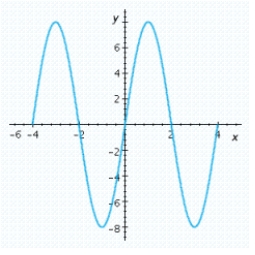
A) period: 8; amplitude: 8
B) period: 4; amplitude: 16
C) period: 2; amplitude: 16
D) period: 4; amplitude: 8
E) period: 2; amplitude: 8

A) period: 8; amplitude: 8
B) period: 4; amplitude: 16
C) period: 2; amplitude: 16
D) period: 4; amplitude: 8
E) period: 2; amplitude: 8

Unlock Deck
Unlock for access to all 25 flashcards in this deck.
Unlock Deck
k this deck
20
Consider the function on the interval . Determine the -intercepts by giving the -coordinate(s).
A)
B)
C)
D)
E)
A)
B)
C)
D)
E)

Unlock Deck
Unlock for access to all 25 flashcards in this deck.
Unlock Deck
k this deck
21
Graph the function for one period, and show (or specify) intercepts and asymptotes.
A)x-intercept: none; y-intercept:
; asymptotes: and
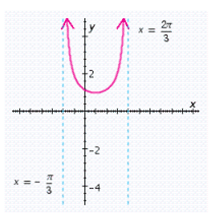
B) x-intercept: none; y-intercept:
; asymptotes: and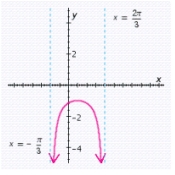
C) x-intercept: ; y-intercept: ; asymptotes: and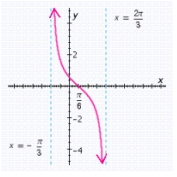
D) x-intercept: ; y-intercept: ; asymptotes: and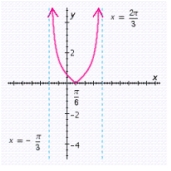
E) x-intercept: ; y-intercept: ; asymptotes: and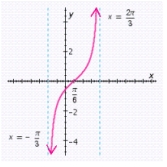
A)x-intercept: none; y-intercept:
; asymptotes: and

B) x-intercept: none; y-intercept:
; asymptotes: and

C) x-intercept: ; y-intercept: ; asymptotes: and

D) x-intercept: ; y-intercept: ; asymptotes: and

E) x-intercept: ; y-intercept: ; asymptotes: and


Unlock Deck
Unlock for access to all 25 flashcards in this deck.
Unlock Deck
k this deck
22
Graph the function for one period, and show (or specify) intercepts and asymptotes.
A) x-intercept: none; y-intercept: none; asymptotes: , and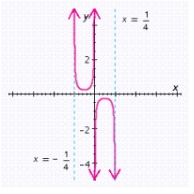
B) x-intercept: none; y-intercept: none; asymptotes: , and
C) x-intercept: none; y-intercept: none; asymptotes: and
Chapter 8
Answer Section
MULTIPLE CHOICE
D) x-intercept: none; y-intercept: none; asymptotes: , and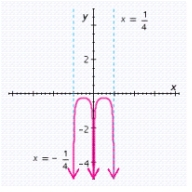
E) x-intercept: none; y-intercept: none; asymptotes: , and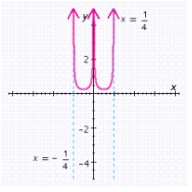
A) x-intercept: none; y-intercept: none; asymptotes: , and

B) x-intercept: none; y-intercept: none; asymptotes: , and

C) x-intercept: none; y-intercept: none; asymptotes: and

Chapter 8
Answer Section
MULTIPLE CHOICE
D) x-intercept: none; y-intercept: none; asymptotes: , and

E) x-intercept: none; y-intercept: none; asymptotes: , and


Unlock Deck
Unlock for access to all 25 flashcards in this deck.
Unlock Deck
k this deck
23
Graph the function for one period, and show (or specify) intercepts and asymptotes.
A) x-intercept: none; y-intercept: none; asymptotes: , and
B) x-intercept: none; y-intercept: none; asymptotes: and
C) x-intercept: none; y-intercept: none; asymptotes: , and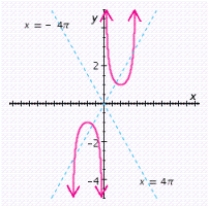
D) x-intercept: none; y-intercept: none; asymptotes: , and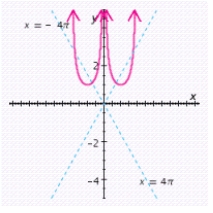
E) x-intercept: none; y-intercept: none; asymptotes: , and
A) x-intercept: none; y-intercept: none; asymptotes: , and

B) x-intercept: none; y-intercept: none; asymptotes: and

C) x-intercept: none; y-intercept: none; asymptotes: , and

D) x-intercept: none; y-intercept: none; asymptotes: , and

E) x-intercept: none; y-intercept: none; asymptotes: , and


Unlock Deck
Unlock for access to all 25 flashcards in this deck.
Unlock Deck
k this deck
24
Graph the function for one period, and show (or specify) the intercepts and the asymptotes.
A)
B)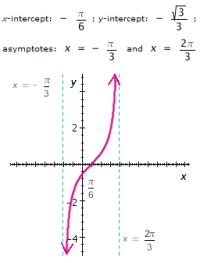
C)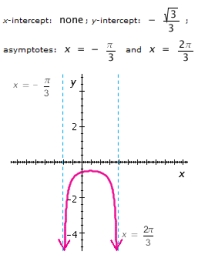
D)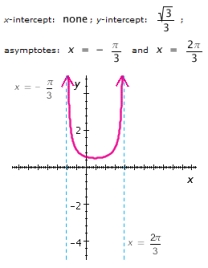
E)
A)

B)

C)

D)

E)


Unlock Deck
Unlock for access to all 25 flashcards in this deck.
Unlock Deck
k this deck
25
Graph the function for one period, and show (or specify) the intercepts and the asymptotes.
A)
B)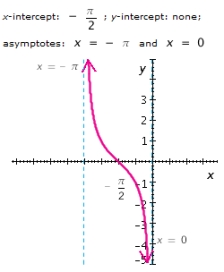
C)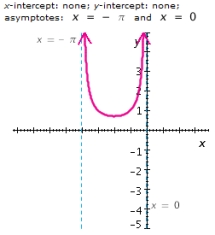
D)
E)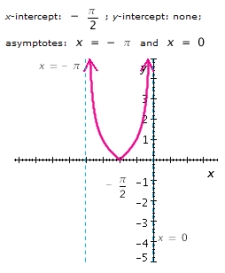
A)

B)

C)

D)

E)


Unlock Deck
Unlock for access to all 25 flashcards in this deck.
Unlock Deck
k this deck



